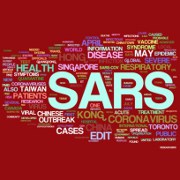Since SARS is a viral infection, antibiotic usage proves futile unless secondary conditions such as bacterial, atypical pneumonia have presented itself. In such cases, strong antibiotics are prescribed to tackle the secondary bacterial condition. Treatments otherwise, are supportive and always done by restricting patient movement in public. Quarantine is essential and negative pressure rooms are recommended. Such rooms suck in air when the doors of the room are opened thereby preventing the germs of the room to spread through the opening.
Other supportive options include treating symptomatic afflictions through the use of antipyretics to keep the fever down, usage of ventilator support to facilitate breathing and oxygen delivery to lungs. Mechanical devices are used to extract sputum and phlegm out of the lungs and airway passage.
Apart from this, antiviral medications such as Ribavirin are also given and steroids may be prescribed to mitigate inflammation in the lungs.
Some complications that may arise just prior or during treatment are those of respiratory, liver or heart failure in severe and acute cases.
Severe and prolonged sequelae exist for SARS treated patients. These include conditions such as osteoporosis, pulmonary fibrosis, depressive disorders and femoral necrosis (i.e scarring of the lung when the air sacs develop fibrotic tissues)
Prevention is best when zero contact with infected individuals is practiced. Other methods of helping prevent the spread of the disease are through:
Covering the mouth with tissues while coughing and/or sneezing;
Disposing the tissue after single use into a bin;
Limiting travel to infected areas and persons;
Avoiding contact with persons showing signs of cold or SARS for a week after they are ‘normalised’;
Cleaning hands preferably by washing with soap and water frequently. The next best option is to use an alcohol-based hand sanitizer;
Avoid frequent touching of lip, mouth and eye without cleaning the hand or fingertips first; and
Use of the correct mask when travelling or visiting crowded markets etc.
You may read more about SARS at the WHO site http://www.who.int/csr/sars/casedefinition/en/ and also refer to the CDC site http://www.cdc.gov/ncidod/sars/ to see what steps the government is taking to monitor the disease.
Mamta Singh is a published author (Migraines for the Informed Woman –- Tips from a Sufferer. Publisher: Rupa & Co.), seasoned business, creative and academic writer. She is a certified fitness instructor, personal trainer & sports nutritionist through IFA, Florida USA. She is the lead writer and holds Expert Author status in many well-received health, fitness and nutrition sites. Mamta runs her own popular blogs on migraines in women and holistic health. Mamta holds a double Master's Degree in Commerce and Business, and is presently training as a Holistic Healing Therapist from the U.K. She is a registered practitioner with the UN recognised Art of Living Foundation.
Link: http://www.migrainingjenny.wordpress.com and http://www.footstrike.wordpress.com





Add a CommentComments
There are no comments yet. Be the first one and get the conversation started!